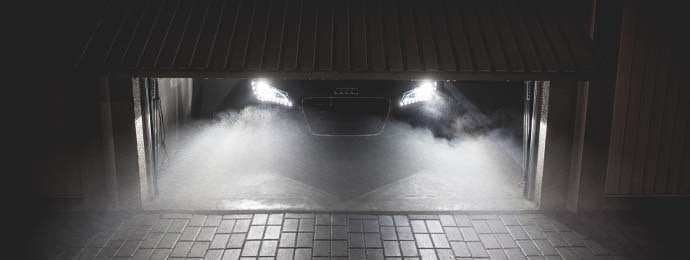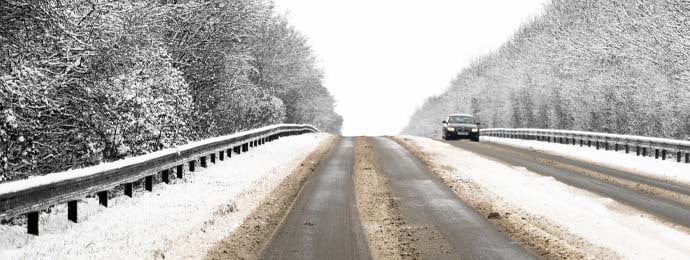How to Drive in Extreme Weather
Worried about driving in adverse weather such as heavy rain, wind, ice, snow, and fog? Car leasing experts, Nationwide Vehicle Contracts, has put together a guide detailing how to prepare yourself and your car, what to take with you, and how to stay safe whilst on the roads.
This guide covers:

If you're reading this, you're probably experiencing extreme weather (sigh). The first port of call should be to check just how severe the weather is. The Met Office work on a three-tier warning system that ranks extreme weather in terms of how dangerous it is, ranging from yellow, amber and red.
Yellow weather warning
Yellow serves as a warning, many people will be able to carry on as usual, but some will be affected. Examples of this include strong winds and rain. Travel delays may occur, and motorists should plan ahead before leaving the house.
Amber weather warning
Amber means that there is a potential risk to life and people should be prepared to change their plans to keep themselves safe. Some roads will be closed, and power cuts are expected. You can still drive in an amber warning, but you shouldn't travel unless it's essential. Examples include moderate snowfall, storms, and gales.
Red weather warning
A Red warning means extremely bad weather and a risk to life is likely. Examples include heavy snowfall, extreme storms, and abnormally cold temperatures. People in the area should take appropriate action to protect themselves and their families. You should NOT in any circumstances leave the house for a drive.
You can find the Met Office weather warnings on their website. If you're using a smartphone to check the weather, each weather app will have its own warning system similar to the Met Office.
You can also look on the National Highways website and regional Twitter accounts for live travel updates, including a handy interactive map where you can scroll and zoom in on your given location.
Winters in the UK can be unpredictable beasts, and if the last few years have been anything to go by, we are in for our fair share of extreme weather. At the start of winter, every motorist should double check their winter car maintenance to ensure its safe to drive in these harsh conditions.
Good winter car maintenance can save the driver time, effort and money once cold season comes about. Nationwide Vehicle Contracts guide (linked above) talks about this in more detail, but here are a few key points:
- Check your car battery is working to the best of its ability. It will be put under more strain in winter through the use of the heater, wipers and lights.
- Check oil, water and screen wash levels. Ensure there is a 50:50 split of antifreeze and water; this can protect the engine down to -34C. To check which antifreeze is good for your car, Halfords have put together a guide
- Check the tread depth of your tyres. The legal requirement in the UK is 1.6mm but experts advise that in winter make sure you have at least 3mm of tread.
- Decide whether the journey is necessary first. If it's not, you should wait and postpone it until the weather has passed.
- If you are heading out, plan your journey. Extreme weather often makes side roads significantly more dangerous, so stick to the main roads even if it means adding a few minutes onto your trip.
- Ensure your car is working correctly. Check all the essential components in your vehicle are working. Some common ones used in extreme weather are the lights, wipers, and brakes.
- Also, ensure you know the location of the important components in your car. If you can't figure this out sat behind the wheel, check your car's handbook and all will be revealed.
- Prepare to be in traffic. Regardless of whether your journey is long or small, ensure you have a drink and some food with you to be sure.
- Finally, make sure you have your mobile phone with you. If you get stuck, it means you can call for help.
In the last thirty years, the UK has been on average 6% wetter than the previous thirty years. Also, it has had its wettest February, December, April, June, and November – five out of 12 months – in a little over a decade (Met Office).
Driving during the rain can be hazardous, especially if driving at high speeds. A combination of a slippery road surface and decreased visibility can prove challenging. Because of this, it's no surprise that nine out of ten weather-related deaths and severe injuries on the roads take place in the rain (Met Office).
Additionally, flooding is becoming more common in the UK. Currently, 2.4 million properties are at risk from river and coastal flooding each year, and in England alone one in six homes are at risk of flooding (Rainbow International Restoration).
Nobody enjoys driving in heavy rain and flooded areas, but many of the challenges can be reduced if you know what to do.
How to prepare
- If you live in an area susceptible to flooding, make sure you avoid roads that frequently overflow. This will save you time on your journey and maintain the condition of your car.
- Move your car to higher ground if flooding is expected.
- Check the tread depth of your tyres. If driving on all-season tyres like most people, a minimum depth of 3mm is advised.
- Check your wipers and lights are working. When it's raining, visibility is limited and spray from cars in front worsens it, so double check your wipers and head/brake lights.
- Make sure you have enough petrol. Often in the rain, you're stuck in traffic whilst also using your lights, heater, and wipers, which drain fuel.
On the road
- In wet weather, stopping distances more than double. Slow down gradually to ensure enough room between you and the car in front just in case you need to brake suddenly.
- A commonly asked question is, 'should I drive through flood water?' The simple answer is no. The safest course of action is to turn around; 12 inches of water can float your car, and just a cup of water sucked into the engine can lead to severe damage, so make sure you avoid the risk (Met Office).
- Be considerate to pedestrians and cyclists. If you purposely splash them, you could be fined and get points on your license.
- If you break down, keep your bonnet shut to avoid further water damage to the engine.
Driving in thick fog is tricky for all motorists, regardless of age or experience. Visibility is significantly hindered, and you need to be careful of anything that may appear out of thin (or thick) air.
Some of the worst road accidents in the UK have been caused by extremely foggy conditions. The most recent incident was in 2013 when 60 motorists were injured in a 130-car crash on the Sheppey crossing in Kent, with eight seriously injured.
Fog at night-time is a recipe for disaster in terms of driving as your already-reduced visibility is further hindered. For tips on how to drive in the dark, check out our handy blog guide.
The main counter to fog is using your fog lights. Fog lights are pointed downwards to illuminate the road below the fog, helping the driver see where they are going. But in instances of thick fog, sometimes more action needs to be taken.

What to check before driving in foggy weather
- Make sure you know how to use your car's front and rear fog lights and where they are located. This will save you stressing over trying to find them whilst driving.
- If fitted with air conditioning, enable it to stop the windows from misting up when you get in the car. Also, ensure the de-mister is on the windscreen and open all the vents.
What do whilst driving in foggy weather
- Ensure that you're using dipped headlights and not your full beam lights. Full beam will reflect off the fog reducing visibility even further!
- Follow the 'three-second rule' between you and the car in front.
- Stay in lane. Bad fog can cause some drivers to drift into the middle of the road without realising; make sure you stay vigilant.
- If visibility is especially poor, open your window to listen for traffic at junctions.
- If the fog has cleared, you must switch off your fog lights according to rule 226 of The Highway Code. If you don't do this, you could be handed a Fixed Penalty Notice with a £50 fine.
Brits can generally handle most types of weather, but when it starts to snow, all hell breaks loose.
Schools and colleges are cancelled, there are street-wide snowball fights, and your social media will be full of motorists battling against the elements to control their cars. This may be amusing to watch, but not if you're the driver.
So how can you drive safely in the snow?
Prepare your car
- The first and most important thing is clear your car of snow. The Highway Code states that you must be able to see out of every glass panel, so don't discriminate against your back windows.
- Pack your car accordingly. Make sure you have some de-icer and an ice scraper on board. Also, if you're expecting heavy snowfall, it may be worth investing in a small shovel to help remove snow quicker.
- Allow more time for your journey and plan your route accordingly.
- If you live or have just moved to an area with heavy snowfall, it would be worth purchasing winter tyres. They allow for greater grip and traction and are worth it if you drive in the snow a lot.
- Another wise purchase would be a snow chain. They offer the best grip in snowy conditions and are well suited to deep snow. However, they must be removed once the snow has cleared to prevent damage to your car and the road.
- If driving a modern automatic, find out how to switch to your car's dedicated snow mode. This will keep gear ratios high to avoid wheel spin.
Whilst on the road
- Keep well back from the driver in front. Stopping distances can be ten times greater than on dry roads, so be sensible.
- When going around a bend, brake gradually and steer smoothly. Try and avoid jolting the wheel which could cause the car to skid.
- Drive at a slower speed than usual and in as high a gear as possible. When stationary, try and drive off in second gear. This will help you keep control and provide as much grip on the road as possible.
Freezing temperatures in the UK are a rarity, but when they do come, they cause havoc on the roads. Most of the time, local councils are prepared and will grit the roads to help eliminate most of the ice, but they can't cover every street.
The most dangerous threat to road users is black ice. Black ice is invisible to the naked eye and is almost impossible to spot when behind the wheel.
Driving on black ice can cause your car to slip and slide, posing a danger to the driver and other road users.
Common locations where black ice forms
Black ice typically forms in shaded areas, where the water on the ground hasn't had enough sunlight to evaporate. But it can also form on raised roads where air passes underneath and keeps the surface cold.
The areas you should most look out for are bridges, overpasses (and underpasses) and spots on the road shaded by buildings and other objects.
How to drive in areas of black ice
- Keep the steering wheel straight to prevent vehicle sliding and losing control.
- Maintain a slow and consistent speed and try not to brake if possible. If coming to a stop, take your foot off the accelerator and try and make the car stop on its own.
Unlike any other vehicle, EVs don't have gears. This makes for a lot of confusion surrounding EVs and how they drive in the snow and freezing temperatures. Should you consider buying one if you live in an area that receives heavy snow or ice in the winter?
Pros:
- Many EVs have thermal management, so they can be warmed up before driving. This means that windows can be quickly defrosted by the car itself. This can be done from your phone for some EVs such as Tesla.
- It doesn't take any time for an electric engine to heat up. You can get in the car after a freezing cold night and drive off.
- As EVs don't have gears, pulling away slowly on snow or ice can be effortless.
- EVs are heavy as they require a larger battery than usual, this helps on snow or ice with traction.
Cons:
- EVs typically have low-resistance tyres to ensure lower energy consumption; this results in less traction in winter conditions.
- Harsh winter temperatures can affect the range of an EV's battery. Studies by Inside EVs have shown that cold conditions could reduce range by up to 20%.

Extreme wind poses the biggest threat to cars when crossing an open stretch of road, such as a bridge or gaps in a row of buildings. Wind rarely blows consistently at the same speed, and sudden gusts can blow your car off course, making it dangerous to you and other road users.
Furthermore, extreme gales can topple trees, and blow debris such as dustbins and litter onto the road.
Tips for driving in windy weather
- Like always, plan your route and keep track of traffic updates. This is especially important in windy conditions as there's a greater chance of roads being closed because of debris on the road and toppled vehicles.
- Slow down. If there's a sudden gust, it won't blow you as far off course as if you were driving at a higher speed.
- Leave the extra room when rounding cyclists or overtaking to accommodate movement across the road.
- Keep your distance from high-sided as they are most susceptible to turbulence.
To learn more about how to stay safe on the roads, check out some of our comprehensive motoring guides for all things car-related or call Nationwide Vehicle Contracts on 0345 811 9595 to speak to one of our car leasing experts.
Guide Information
Originally published: 4th January 2023
Last updated: 4th January 2023
